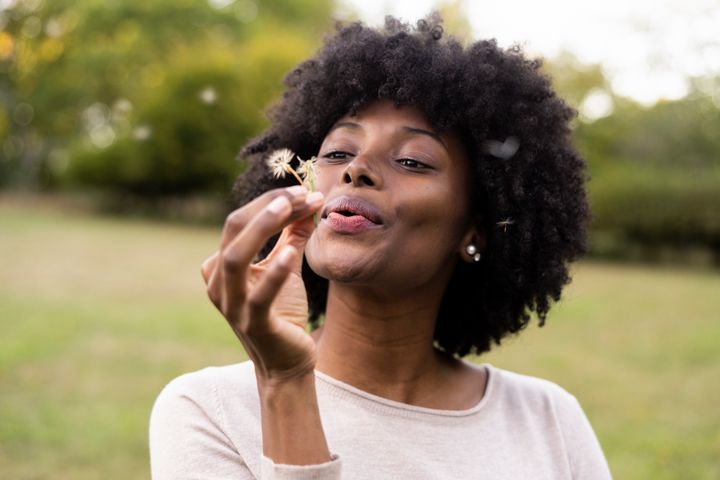
All over social media, mental health experts and advocates are posting about “glimmers.” The videos show kids collecting flowers in a field, folks sipping a quiet cup of tea on their porch, or having a swim at the local lake, among other peaceful moments.
Simply put, glimmers are small moments that bring you joy. The term was coined by Deb Dana, a Maine-based licensed clinical social worker whose work centers on complex trauma. The posts are calming, pretty and even awe-inspiring ― but do they do anything aside from look or sound pretty?
“Glimmers are these micro-moments of safety, connection, regulation,” Dana told HuffPost.
“It is the tiny moments of joy, the moments of ‘okayness’ that take us away from being stuck in this challenging world we’re in, or our own trauma that’s sitting unprocessed, and it ... helps build the capacity to then manage these other things in a different way,” Dana said.
In other words, glimmers are there to help balance out the bad, but should not be mixed up with toxic positivity. Dana stressed that society often only looks at the silver lining, which is not the point of glimmers, they are not here to mute the hard days but are instead here to make the hard days more manageable.
“Glimmers are a reminder that our nervous system is so amazingly able to hold all of the trauma and ... notice the micro-moments of joy, of safety, of connection, of whatever the flavors we want to talk about,” Dana said.
Here’s how to find your glimmers and what to do with them once you’ve found them:
First, understand that glimmers are unique to you.
“What is a glimmer for you might be a trigger for me,” Dana said. “It doesn’t mean it’s right or wrong, it simply means this is how our nervous systems experience this moment.”
For example, someone may find glimmers at the beach while someone with a crippling fear of the ocean may need to avoid the beach altogether. And that’s OK.
Justine Grosso, a psychologist in North Carolina who also shares mental health insight on her Instagram account, added that it’s up to the individual to determine what brings them a sense of awe or joy — and, once again, there is no wrong answer.
It shouldn’t be hard to find your glimmers, Dana noted. They’re moments that stop you in your tracks and make you feel good, like an autumnal leaf on your walking route or the sound of a singing bird outside of your kitchen window.
There are different types of glimmers, Dana noted. “Glimmers that make me happy, glimmers that make me feel peace, glimmers that bring a sense of magic.”
Think about a place you really like, like a nearby riverfront, a state park, a museum or a walking trail, and head there to find your glimmers.
“Some common examples are seeing a really beautiful flower if you go on a slow walk in nature, bird sounds, you might notice a really tiny little animal … if you’re walking through the city you might make eye contact with someone, you might notice someone smiling at you, you might see a really cool piece of art,” Grosso said.
If you see something that makes you stop and gives you a sense of awe, calm or connectedness, you’re likely looking right at a glimmer.

Glimmers can help you regulate stress in your body.
“Oftentimes, when we’re doomscrolling we’re disconnecting from the body and kind of numbing out,” Grosso said, but glimmers are “a really nice way to reconnect to feeling safe in our bodies.”
This is especially true for people with a history of trauma, depression or anxiety, who may have a harder time feeling safe.
“Finding glimmers ... not only is a nice skill for the moment to remind us that we can reconnect with a sense of calm and safety and groundedness, but if we make it a regular practice over time it actually can increase our capacity for stress so we get triggered less over time,” Grosso added.
What’s more, you don’t have to be dealing with trauma to benefit from glimmers, Dana noted.
“We all have challenging moments. All of us. And whether we want to call it trauma or we just want to call it moments of feeling overwhelmed, feeling anxious, feeling angry, feeling lonely, we have these moments where we feel that sense of not OK ... and can’t quite meet the moment successfully or in the way I’d like to,” Dana said.
These kinds of tough moments and glimmers go together. “The world is not just glimmerful nor is it just challenging. It is both,” Dana said.
If you can’t go out and find glimmers, that’s OK. There are other ways to evoke the feeling.
Getting out in nature or visiting your favorite museum is certainly part of the glimmer experience, but you likely can’t make these kinds of visits a daily habit.
To feel the peace that glimmers bring more often, Grosso said she takes photos of her glimmers.
“And I have a folder on my phone of all the glimmers I’ve collected,” Grosso said. This way, when she can’t go glimmer hunting, she pulls up the photos.
Additionally, this can allow you to brighten someone else’s day, too.
“It can also be really nice to text photos of glimmers to friends and kind of share that beauty, share the joy,” Grosso said.
To make glimmers even more impactful, find someone to talk about them with.
“I often encourage people to find a glimmer buddy and find a way to share your glimmers,” Dana said. “I have families who … at the end of the day say, ‘What was a glimmer you found today?’ rather than, ‘What was your favorite part of the day?’”
Dana said it could be powerful to not only become aware of your glimmers but to share them with others to create a deeper sense of connection with loved ones.
“There’s something about that that I think is powerful, that knowing that I can look at other people’s glimmers and get a sense of them through their glimmer,” Dana said. And they don’t have to have the same glimmer as you to establish this connection.
“This is a simple way to begin that sense of acceptance and connection. And wouldn’t it be lovely to begin to see that shape our world differently?” Dana added.
It may be a high hope, she pointed out, “but if we bring it down to the basic experience of feeling, seeing, stopping, appreciating and sharing a glimmer then that’s interesting to think where it might that take us.”
To start finding your glimmers, Dana said set a reasonable glimmer intention, which is something she often does with clients. “Set an intention that feels spacious and welcoming to you. If it feels like it’s a demand, you’re going to have a hard time following through.”
Simply tell yourself that you’re open to finding glimmers today and create a scenario — like a walk in the fields or a visit to a gallery — that can make this a reality.
“I think just like any practice it takes repetition ... so just try to be gentle with yourself,” Grosso said. And, if you fall out of the glimmer-finding habit, you can always start again.
It’s never too late or too early to start this practice, and it can be a powerful tool for connection, peace and joy. And who doesn’t want more of that?